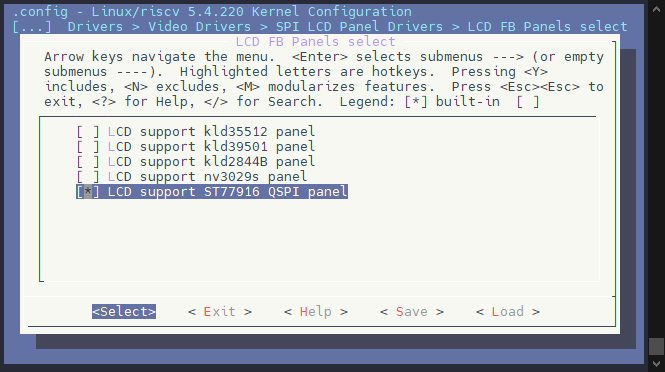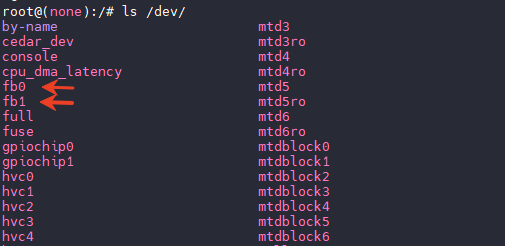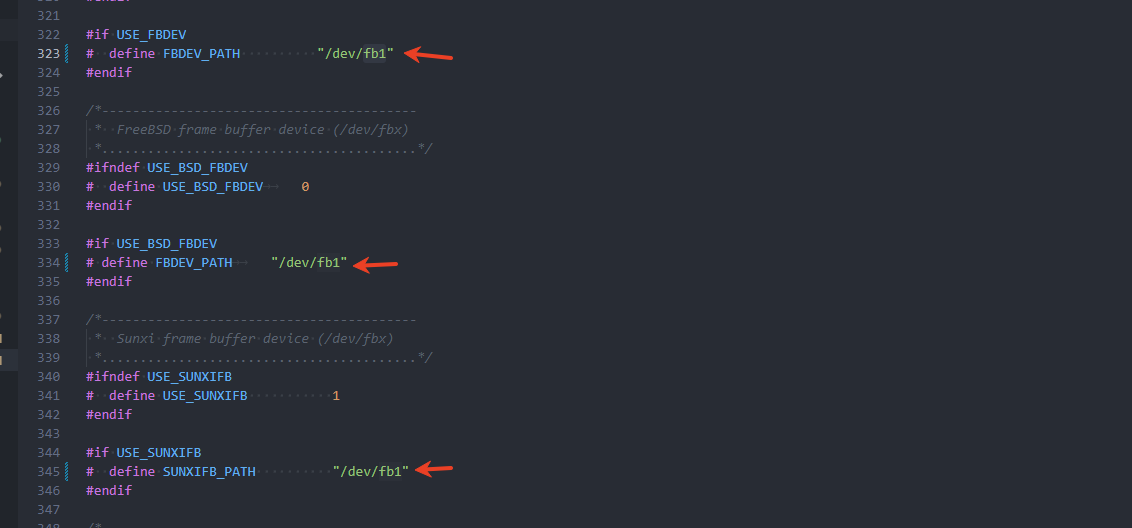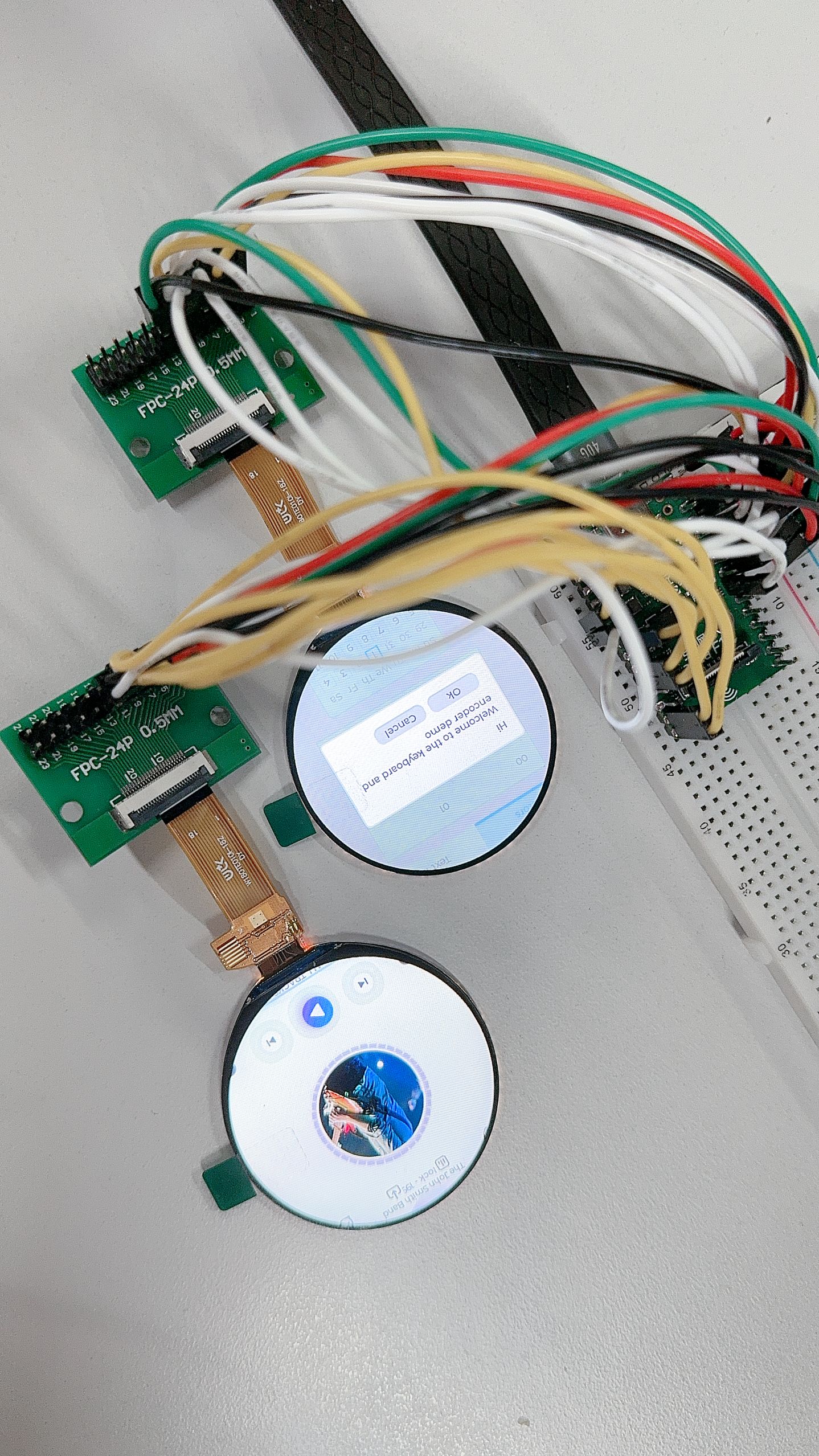QSPI 双屏 ST77916 LCD 异显
此次适配的 QSPI 屏为 W180TE010I-18Z ,使用的是 QSPI 4 线模式进行驱动。
屏幕 1 这里使用 QSPI2,位于 PD1~PD6 上,引脚配置如下:
| V821 | TFT 模块 |
|---|---|
| PD1 | QSPI-CS |
| PD2 | QSPI-CLK |
| PD3 | QSPI-D0 |
| PD4 | QSPI-D1 |
| PD5 | QSPI-D3 |
| PD6 | QSPI-D2 |
| PL6 | RESET |
| 3V3 | VCC |
| GND | GND |
屏幕 2 这里使用 QSPI1,位于 PD14~PD19 上,引脚配置如下:
| V821 | TFT 模块 |
|---|---|
| PD14 | QSPI-CS |
| PD15 | QSPI-CLK |
| PD16 | QSPI-D0 |
| PD17 | QSPI-D1 |
| PD18 | QSPI-D3 |
| PD19 | QSPI-D2 |
| PL7 | RESET |
| 3V3 | VCC |
| GND | GND |
勾选驱动
Allwinner BSP --->
Device Drivers --->
Video Drivers --->
SPI LCD Panel Drivers --->
<*> LCD FB Driver Support (SPI LCD)
LCD FB Panels select --->
[*] LCD support ST77916 QSPI panel

配置设备树
&pio {
spi1_pins_default: spi1@0 {
pins = "PD14", "PD15", "PD16", "PD17", "PD18", "PD19"; /* CS, SCK, D0, D1, D3, D2 */
function = "spi1";
allwinner,drive = <3>;
};
spi1_pins_sleep: spi1@1 {
pins = "PD14", "PD15", "PD16", "PD17", "PD18", "PD19";
function = "io_disabled";
};
spi2_pins_default: spi2@0 {
pins = "PD1", "PD2", "PD3", "PD4", "PD5", "PD6"; /* CS, SCK, D0, D1, D3, D2 */
function = "spi2";
allwinner,drive = <3>;
};
spi2_pins_sleep: spi2@3 {
pins = "PD1", "PD2", "PD3", "PD4", "PD5", "PD6";
function = "io_disabled";
};
};
&lcd_fb {
status = "okay";
port {
#address-cells = <1>;
#size-cells = <0>;
spi_panel0: endpoint@0 {
reg = <0>;
remote-endpoint = <&panel_st7789v_spi1>;
};
spi_panel1: endpoint@1 {
reg = <1>;
remote-endpoint = <&panel_st7789v_spi2>;
};
};
};
&spi1 {
pinctrl-0 = <&spi1_pins_default>;
pinctrl-1 = <&spi1_pins_sleep>;
pinctrl-names = "default", "sleep";
clock-frequency = <150000000>;
sunxi,spi-bus-mode = <SUNXI_SPI_BUS_MASTER>;
sunxi,spi-cs-mode = <SUNXI_SPI_CS_SOFT>;
status = "okay";
panel_st7789v_spi1: slave@0 {
device_type = "spi-panel";
compatible = "allwinner,spi-panel";
reg = <0x0>;
spi-max-frequency = <150000000>;
spi-rx-bus-width = <4>;
spi-tx-bus-width = <4>;
lcd_used = <1>;
lcd_driver_name = "st77916_qspi";
lcd_if = <2>;
lcd_dbi_if = <0>;
lcd_qspi_if = <2>;
lcd_data_speed_hz = <118153846>;
lcd_x = <360>;
lcd_y = <360>;
lcd_pixel_fmt = <10>;
lcd_dbi_fmt = <2>;
lcd_rgb_order = <0>;
lcd_width = <60>;
lcd_height = <60>;
lcd_pwm_used = <0>;
lcd_pwm_ch = <6>;
lcd_pwm_freq = <5000>;
lcd_pwm_pol = <1>;
lcd_frm = <1>;
lcd_gamma_en = <1>;
fb_buffer_num = <2>;
lcd_backlight = <100>;
lcd_fps = <60>;
lcd_dbi_te = <0>;
lcd_dbi_clk_mode = <0>;
lcd_gpio_0 = <&rtc_pio PL 7 GPIO_ACTIVE_LOW>;
status = "okay";
};
};
&spi2 {
pinctrl-0 = <&spi2_pins_default>;
pinctrl-1 = <&spi2_pins_sleep>;
pinctrl-names = "default", "sleep";
clock-frequency = <150000000>;
sunxi,spi-bus-mode = <SUNXI_SPI_BUS_MASTER>;
sunxi,spi-cs-mode = <SUNXI_SPI_CS_SOFT>;
status = "okay";
panel_st7789v_spi2: slave@0 {
device_type = "spi-panel";
compatible = "allwinner,spi-panel";
reg = <0x0>;
spi-max-frequency = <150000000>;
spi-rx-bus-width = <4>;
spi-tx-bus-width = <4>;
lcd_used = <1>;
lcd_driver_name = "st77916_qspi";
lcd_if = <2>;
lcd_dbi_if = <0>;
lcd_qspi_if = <2>;
lcd_data_speed_hz = <118153846>;
lcd_x = <360>;
lcd_y = <360>;
lcd_pixel_fmt = <10>;
lcd_dbi_fmt = <2>;
lcd_rgb_order = <0>;
lcd_width = <60>;
lcd_height = <60>;
lcd_pwm_used = <0>;
lcd_pwm_ch = <6>;
lcd_pwm_freq = <5000>;
lcd_pwm_pol = <1>;
lcd_frm = <1>;
lcd_gamma_en = <1>;
fb_buffer_num = <2>;
lcd_backlight = <100>;
lcd_fps = <60>;
lcd_dbi_te = <0>;
lcd_dbi_clk_mode = <0>;
lcd_gpio_0 = <&rtc_pio PL 6 GPIO_ACTIVE_LOW>;
status = "okay";
};
};
功能测试
启动后可以执行 ls /dev 查看 framebuffer 节点。

修改 LVGL
配置 LVGL 色深 RGB565,反转 byte,修改文件 platform/thirdparty/gui/lvgl-8/lv_examples/src/lv_conf.h
/*Color depth: 1 (1 byte per pixel), 8 (RGB332), 16 (RGB565), 32 (ARGB8888)*/
#define LV_COLOR_DEPTH 16
/*Swap the 2 bytes of RGB565 color. Useful if the display has an 8-bit interface (e.g. SPI)*/
#define LV_COLOR_16_SWAP 1

LVGL 需要编译两个版本,一个在 fb0 显示,一个在 fb1 显示。
编辑 platform/thirdparty/gui/lvgl-8/lv_examples/src/lv_drv_conf.h,将 fb0 修改为 fb1

勾选 LVGL,运行测试
lv_examples 1
lv_examples_fb1 1
屏幕可以正常显示,帧率正确即可。
